Overview
Navigating a career transition can be daunting, and it’s completely normal to feel overwhelmed. We understand that this period of change can stir up a mix of emotions and uncertainties. However, leveraging key resources during this time is essential for finding your footing and moving forward with confidence. By tapping into your personal, professional, educational, and financial assets, you can empower yourself to embrace new opportunities.
Have you considered conducting a skills inventory? This simple yet effective step can help you identify your strengths and areas for growth. Seeking mentorship can also provide invaluable guidance and support, reminding you that you are not alone on this journey. Additionally, utilizing job search platforms can strategically position you for success in a challenging job market.
Remember, enhancing your employability is not just about finding a job; it’s about building your confidence and taking ownership of your career path. As you explore these resources, know that you have the power to navigate this transition with resilience and grace. Embrace the possibilities ahead, and take that first step toward a fulfilling future.
Introduction
In a world where career paths can feel increasingly unpredictable, mastering the art of transition is essential for your professional growth. We understand that navigating the complexities of a changing job market can be daunting, but knowing how to leverage key resources can truly make all the difference. This article delves into the critical components of a successful career shift, highlighting personal, professional, educational, and financial resources that empower you to take charge of your future.
From identifying your transferable skills to building a robust support network, you will discover actionable strategies and insights that pave the way for fulfilling career transformations. Whether you are facing the challenges of a declining economy or seeking new opportunities, remember that the journey toward career ownership begins with a solid foundation of knowledge and resources. You are not alone in this journey; together, we can explore the path to a brighter future.
Understanding Key Resources in Career Transitions
Navigating a professional transition can be daunting, especially in today’s challenging job economy. It’s important to recognize the key resources available to you during this time. You are not alone in feeling uncertain, and understanding these resources can empower you to take control of your career journey.
Personal Resources: Think about the skills, experiences, and personal networks you already possess. These assets are invaluable. By leveraging your robust transferable skills and the support of your community, you can adapt and thrive in a new professional landscape. Acknowledging these strengths enables you to take charge, particularly in a job market where opportunities may feel limited.
Professional Resources: Consider utilizing tools and platforms that facilitate job searching, such as LinkedIn, job boards, and professional associations. These resources not only connect you with potential employers but also provide insights into industry trends and opportunities. Did you know that over half of LinkedIn members anticipate job changes due to generative AI? Staying informed and adaptable is crucial in this rapidly evolving job market.
Educational Resources: Institutions and online platforms offering courses and certifications can be invaluable for acquiring new skills relevant to your desired professional path. Certificates from recognized programs enhance your competitiveness, demonstrating your commitment to growth. For instance, obtaining a certification in a high-demand area can set you apart from other candidates, opening new doors and allowing you to mitigate risks during your transition.
Having a financial cushion is also essential during this time. This might include savings, grants, or loans that can support you as you navigate these changes. Understanding your financial options can alleviate anxiety, enabling you to focus on your professional objectives. Financial stability empowers you to invest in your personal and professional resources effectively, paving the way toward your goal of financial freedom.
Recognizing and effectively utilizing these key resources lays a solid foundation for your professional shift. In fact, companies that prioritize employee development see 57% higher retention rates, highlighting the importance of investing in your growth. Furthermore, the trend of job-hopping among younger professionals, with those aged 23 to 34 averaging 4.5 jobs, reflects a growing desire for diverse experiences and adaptability.
This shift emphasizes the need for individuals to strategically harness their personal and professional resources. By doing so, you can make informed decisions that empower you to achieve a fulfilling profession 2.0. Additionally, consider exploring case studies of individuals who have successfully navigated job transitions; these stories can provide valuable insights and inspiration for your journey.
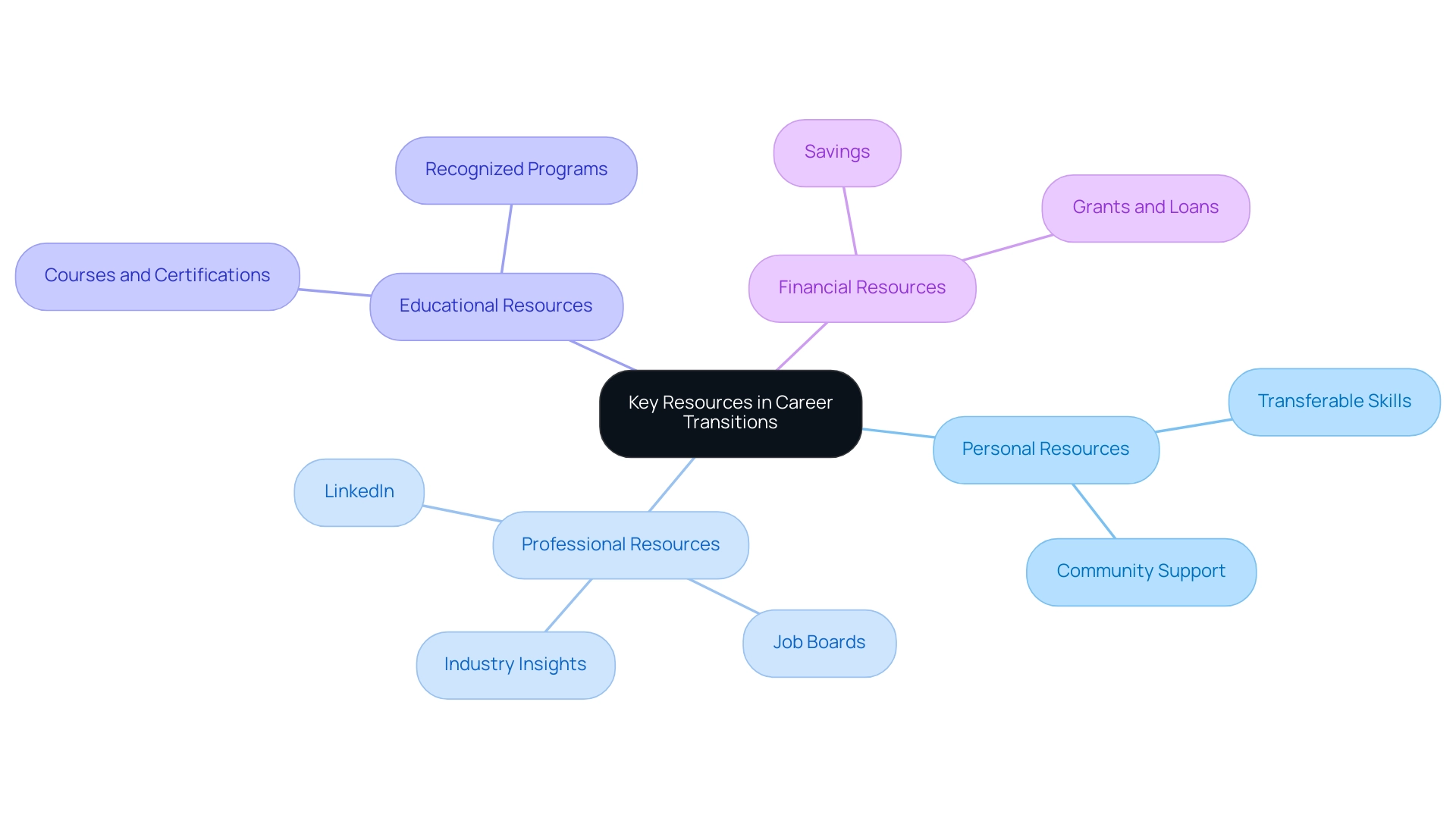
The Role of Human Capital in Your Career Shift
Human capital encompasses the skills, knowledge, and experience individuals possess, playing a crucial role in shaping their professional journeys. In the context of ‘Your Career Revolution,’ particularly in Chapters 5 and 6, the message is clear: there is no time like the present to take charge of your profession. Have you ever felt overwhelmed by the thought of a job change? You’re not alone. Successfully utilizing your key resources during this transition can greatly improve your opportunities.
Here are some key steps to consider:
-
Conduct a Skills Inventory: Begin by cataloging your current skills and experiences that can be transferred to your new profession. This inventory serves as a foundation for understanding your strengths and areas for improvement, aligning with the urgency to act now.
-
Identify Skill Gaps: Research the skills that are in demand within your desired field. Compare these requirements with your skills inventory to pinpoint any gaps that may hinder your transition. Recognizing these gaps is essential in navigating the challenges of employability in today’s competitive job market.
-
Invest in Development: With a clear understanding of your skill gaps, seek out training programs, workshops, or online courses tailored to your needs. Upskilling is particularly vital in 2025, as industries increasingly evolve with new technologies, such as artificial intelligence. As highlighted in a case study on ‘Upskilling and Reskilling for Advancement,’ professionals who invest in both technical and soft skills become indispensable assets, enhancing their opportunities and confidence in a competitive job market. This investment is a crucial step towards achieving financial freedom and lifestyle fulfillment.
-
Showcase Your Skills: Revamp your resume and LinkedIn profile to highlight your enhanced skill set. A well-articulated presentation of your capabilities makes it easier for potential employers to recognize your value.
Statistics indicate that only 30% of employees report high engagement levels, underscoring the importance of proactive professional management. Julia Toothacre, a principal strategist, highlights that “a good manager is transparent and open with their team about the realities of the organization,” which is essential during professional changes. By conducting a thorough skills inventory and addressing gaps, you position yourself as a more attractive candidate in a landscape where 70% of managers anticipate increased workplace tensions.
This proactive method not only assists in your shift but also enhances a more engaged workforce overall.
The Entrepreneur’s Source provides free services and an organized approach to assist individuals in their professional changes, emphasizing the significance of utilizing key resources efficiently. Remember, there is no time like the present to take control of your professional path with Find Your Career 2.0 | Career Ownership Coach Parnell Woodard.
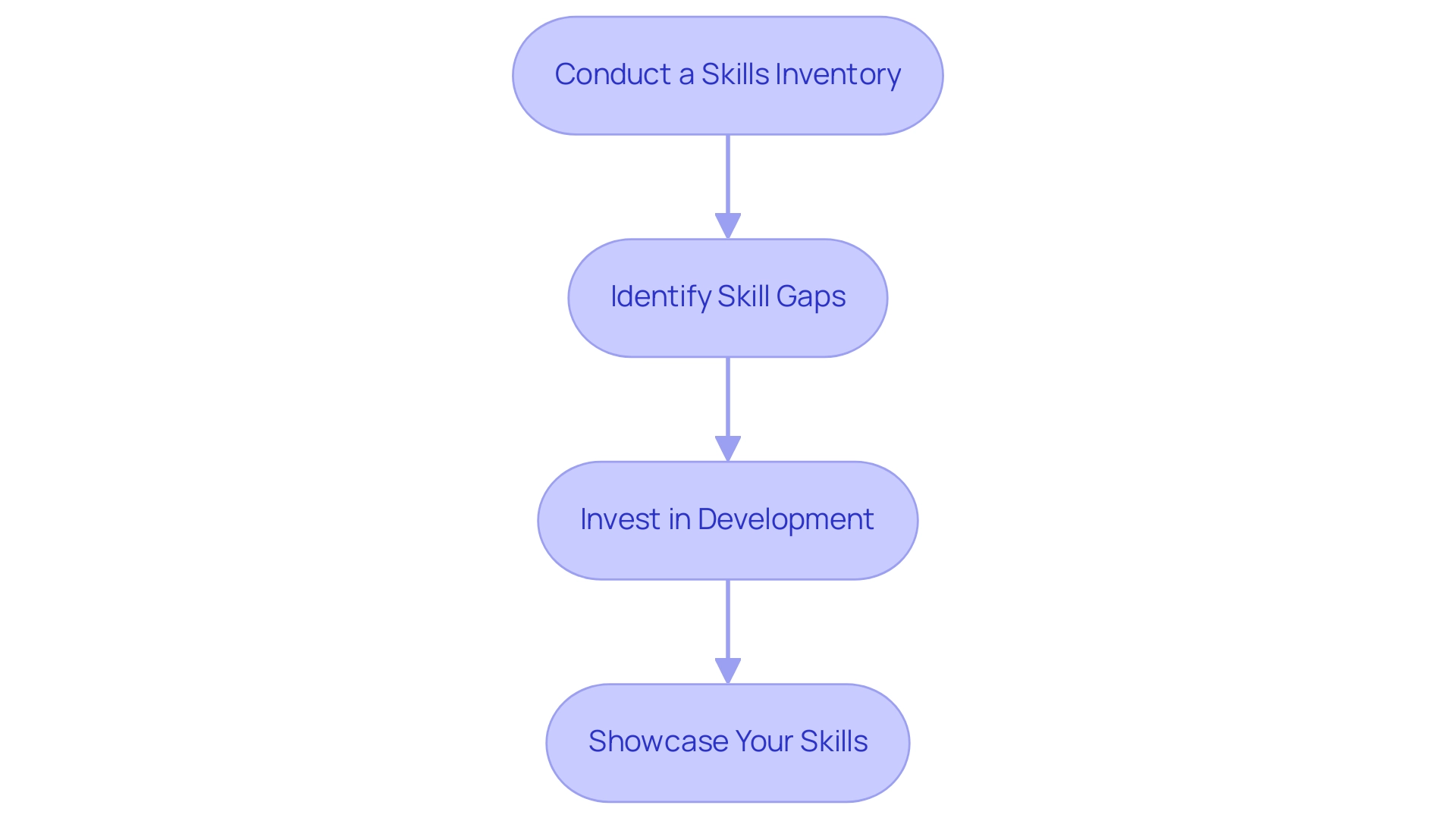
Harnessing Information Technology for Career Advancement
In today’s rapidly changing job landscape, information technology plays a vital role in navigating your career transitions. Here’s how you can harness it effectively:
-
Utilize Job Search Platforms: Websites like Indeed, Glassdoor, and LinkedIn are invaluable for uncovering job openings that resonate with your skills and aspirations. With 230 million LinkedIn users in the U.S., this platform can connect you with potential employers and reveal opportunities tailored to your expertise. As Parnell Woodard, a Career Ownership Coach, notes, “The Entrepreneur’s Source focuses on providing Career Ownership Coaching™ to individuals seeking to explore new professional opportunities.” This coaching can empower you to take charge of your career path, especially in a challenging job market. For further insights, consider downloading the ‘Why work with Parnell’ PDF to discover more resources available for your transition.
-
Engage in Online Learning: Platforms such as Coursera, Udemy, and LinkedIn Learning offer a range of courses designed to help you acquire new skills relevant to your desired profession. With the demand for flexible work arrangements increasing by 24.5% during the Great Reshuffle, enhancing your skill set through online learning can greatly boost your job satisfaction and marketability. Additionally, companies that adopt a hybrid work model could save as much as $11,000 annually, highlighting the economic benefits of flexibility in your career. This adaptability is essential for overcoming professional challenges and achieving financial independence, particularly in a declining job economy.
-
Network Virtually: Social media and professional networking sites are essential for connecting with industry professionals. Engaging in relevant groups and discussions can broaden your network and open doors to new opportunities. Research shows that 52% of talent acquisition teams now utilize centralized texting platforms for candidate communication, underscoring the importance of staying connected in a digital world. Building a strong community can provide support and resources as you navigate your transition, especially since age-related limitations may impact your employability.
-
Leverage Career Development Tools: Take advantage of tools such as resume builders and interview preparation apps to enhance your job application process. These resources can streamline your efforts and improve your presentation to potential employers. With 56% of employers citing a lack of qualified candidates as their biggest challenge, presenting a polished application can distinguish you in a competitive job market. A recent case study revealed that employers face significant hiring challenges, emphasizing the need for improved recruitment strategies. By focusing on your transferable skills and showcasing your achievements, you can mitigate risks and accelerate your new path. Additionally, consider the importance of budgeting for a longer active life expectancy, as this will be crucial for your economic security in the future.
By effectively utilizing these resources, you can navigate your professional change with greater confidence and clarity, ultimately leading to personal empowerment and financial freedom.
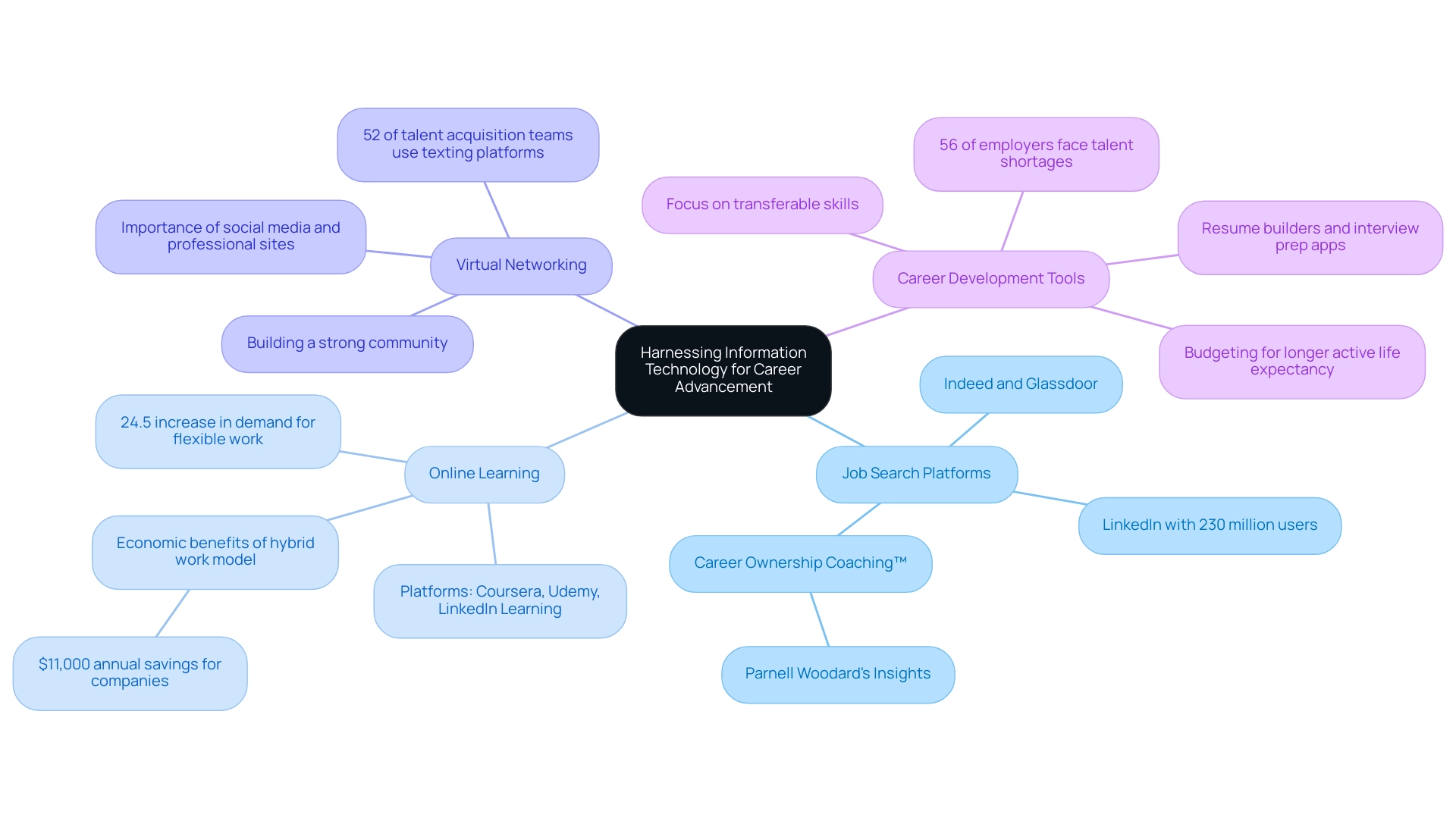
Building a Support Network: Coaching and Mentorship
Building a strong support network is essential during a job transition, especially in today’s challenging employment landscape. It’s important to remember that you are not alone in this journey. Here are effective steps to create a nurturing network:
-
Identify Potential Mentors: Have you thought about seeking out individuals within your target industry who can offer valuable guidance? Research shows that employees with formal mentors are 38% more likely to feel supported in achieving their professional objectives compared to those without. Mentoring can significantly enhance your journey, as participants often experience a 19% advancement rate over non-participants. This highlights the vital role mentorship plays in navigating job transitions and overcoming the limitations of traditional employment options.
-
Join Professional Associations: Engaging with organizations relevant to your new professional path can be incredibly beneficial. These associations not only provide access to key resources and training but also facilitate connections with like-minded professionals. It’s worth noting that 51% of Gen Z employees feel their education hasn’t adequately prepared them for the workforce. This underscores the importance of ongoing professional development and networking opportunities that can help you build transferable skills and enhance your employability.
-
Seek Coaching Services: Have you considered hiring a professional coach? A coach can deliver personalized advice and strategies tailored to your unique situation. A structured coaching method can help clarify your objectives and identify key resources, boosting your confidence during this change. Services like those offered by Find Your Career 2.0 can assist you in navigating your professional ownership journey efficiently, emphasizing economic independence and personal agency.
-
Participate in Networking Events: Attending workshops, seminars, and conferences can broaden your network and provide fresh perspectives. Engaging in these events often leads to meaningful connections and potential mentorship opportunities. For instance, companies that invest in mentoring initiatives, such as Paychex’s program for high-potential women, have seen retention rates soar to 94%. This demonstrates the effectiveness of structured support systems in professional environments. Additionally, the case study titled “Mentoring for Upskilling and Retention” illustrates how investing in mentoring for reskilling existing employees can yield significant cost savings for organizations, reinforcing the argument for building a support network.
By actively creating a support network, you can greatly improve your opportunities for a successful shift. Remember, utilizing the knowledge and experiences of others can steer your path towards economic independence and a fulfilling profession.
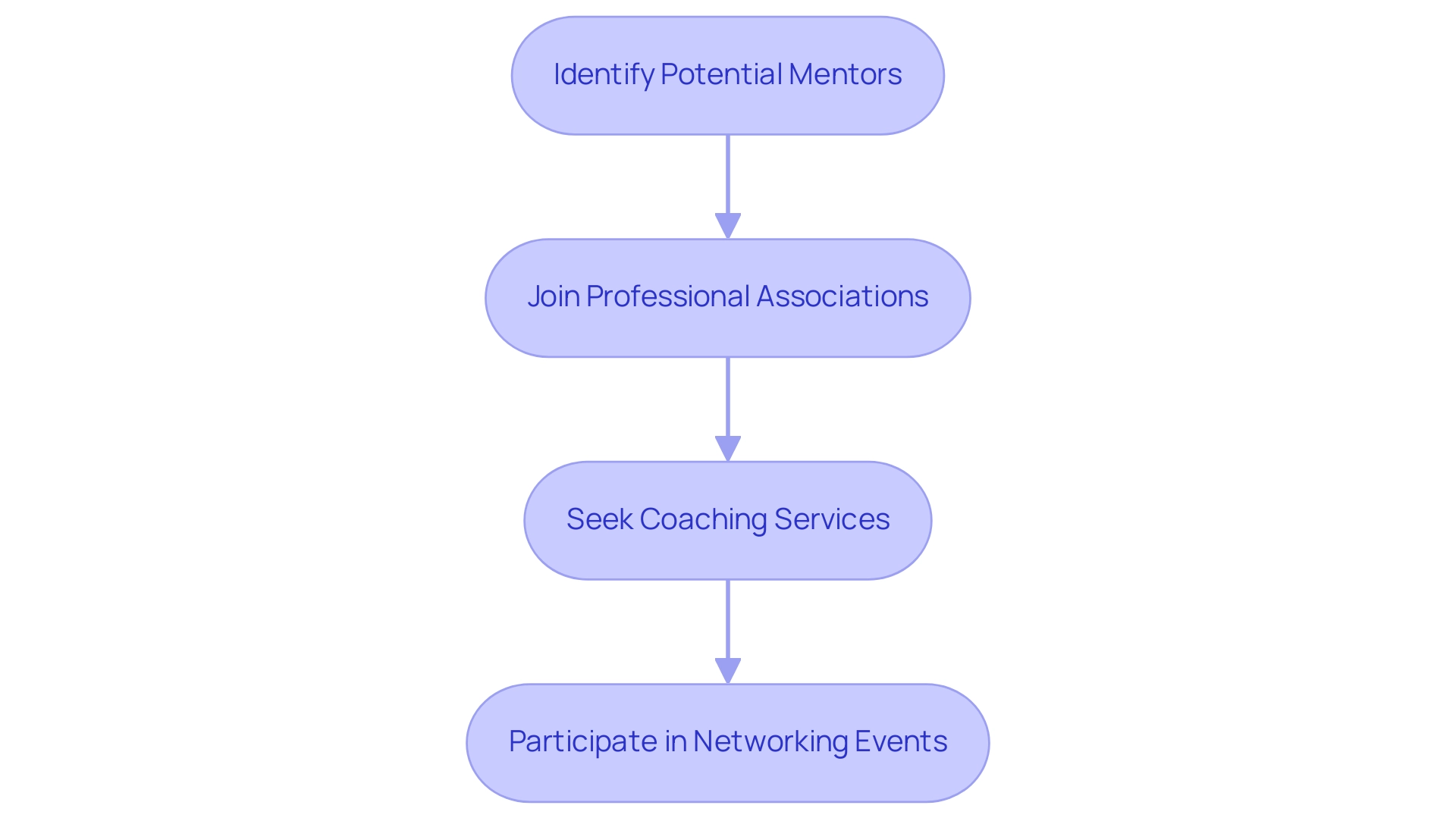
Financial Planning: Securing Resources for Your Transition
Navigating a job shift can be daunting, and an efficient monetary strategy is crucial for ensuring a smooth transition. Let’s explore some key steps that can help you feel more secure during this time.
-
Assess Your Current Financial Situation: Begin by taking a close look at your savings, monthly expenses, and any potential income gaps that may arise during your transition. Understanding your economic landscape is essential for making informed choices, especially in a job market that feels increasingly restrictive.
-
Create a Budget: Developing a comprehensive budget that reflects your living expenses and any costs associated with your career change is vital. This budget should encompass both fixed and variable expenses, providing you with a clear picture of your financial needs. Remember, you are not alone in this; many individuals face similar challenges.
-
Recent statistics show that employees aged 23-34 have held an average of 4.5 positions, underscoring the importance of adaptability in budgeting. As highlighted by Careershifters, over half of LinkedIn members anticipate job changes due to generative AI, making it even more critical to have a solid budget plan in place.
-
Explore Funding Options: Investigate various funding opportunities such as grants, scholarships, or loans available for those pursuing new professional paths. These resources can offer essential financial assistance, helping you reduce risks and accelerate your transition.
-
Build an Emergency Fund: Aim to save at least three to six months’ worth of living expenses. This financial cushion can alleviate stress and provide stability during your transition, allowing you to focus on new opportunities without the pressure of immediate financial concerns. In today’s fast-paced job market, having a safety net can empower you to take control of your career destiny.
-
Leverage Expert Insights: Budgeting during a professional transition is not just about managing expenses; it’s about strategically planning for your future. Engaging with investment consultants can provide personalized guidance that aligns with your professional objectives. Remember, CFOs can lead FP&A transformation by integrating it into enterprise strategy, serving as a model for enhancing planning during transitions.
-
Learn from Successful Case Studies: Consider the case studies in ‘Your Career Revolution,’ which illustrate how individuals have successfully navigated professional transitions through effective monetary planning. For instance, strategic collaboration among departments has shown that improved cooperation can lead to better economic outcomes. By acting as intermediaries between finance and other divisions, you can create value and enhance your professional strategies, emphasizing the importance of incorporating economic insights into your planning.
Moreover, focusing on adaptable skills and connecting with your community can provide significant support and resources throughout your change. By following these steps, you can build a strong financial foundation that offers the resources necessary to bolster your professional shift. This empowers you to take charge of your vocational future and manage the challenges of a fluctuating economy.
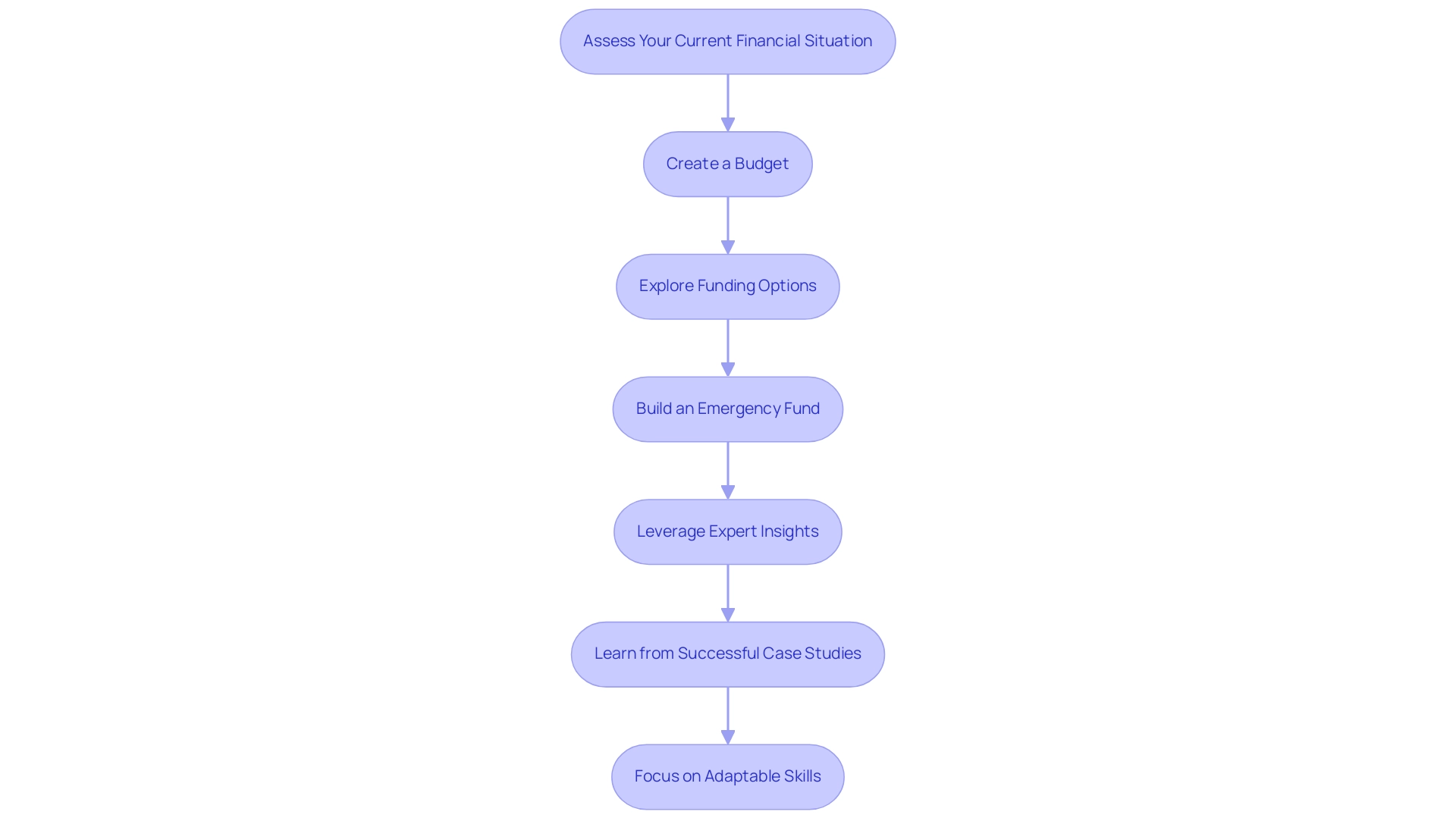
Educational Resources: Upskilling for New Opportunities
Upskilling is an essential part of navigating a successful professional shift, especially when faced with challenges like the Battered Career Syndrome and Investor Syndrome. As highlighted in ‘Your Career 2.0: A Survival Guide for The Battered Career Syndrome and Investor Syndrome,’ this comprehensive guidebook is a vital resource for anyone eager to take charge of their future through business ownership. Here’s how you can effectively access educational resources:
-
Research Relevant Courses: Have you considered identifying courses that align with the skills needed in your desired industry? Platforms like Coursera and edX offer a diverse range of options tailored to various fields, helping you build a solid foundation in the competencies that employers truly value.
-
Attend Workshops and Seminars: Engaging in local or online workshops focused on skill development and current industry trends can be incredibly beneficial. These events not only provide valuable knowledge but also create networking opportunities that connect you with industry professionals and potential mentors.
-
Consider Certifications: Obtaining certifications can greatly enhance your resume, showcasing your commitment to professional growth. In 2025, statistics indicate that 39% of small businesses are utilizing classroom-led training, while 17% are adopting virtual classrooms. This trend reflects a growing preference for flexible learning options. Certifications can set you apart in a competitive job market, especially as you transition towards business ownership.
-
Utilize Community Resources: Have you explored local community colleges or workforce development programs that offer affordable training options? Many of these institutions serve as key resources by providing customized courses designed to meet the needs of individuals seeking to change professions, making them invaluable for your upskilling journey.
-
Leverage Educational Resources: The importance of continuous learning cannot be overstated. By 2025, companies are increasingly investing in learning and development, with many planning to enhance their financial commitments in this area. This trend underscores the significance of upskilling as a strategic step for individuals transitioning in their careers. As Parnell Woodard, a Career Ownership Coach, emphasizes, “We are dedicated to assisting clients in transitioning from traditional employment to ownership of their work, empowering them to achieve their professional goals.”
-
Explore Successful Case Studies: Have you looked into case studies that showcase successful educational resources for individuals transitioning professions? For example, businesses that have embraced blended learning techniques—combining classroom and online training—report improved employee performance and satisfaction. This approach not only caters to diverse learning preferences but also fosters a culture of continuous improvement.
By actively pursuing these key resources, as suggested in ‘Your Career 2.0,’ you can equip yourself with the skills and knowledge necessary to thrive in your new professional journey. Furthermore, the metrics on professional growth and leadership skills development indicate that investing in your education is not just advantageous but essential for long-term success in your career shift.
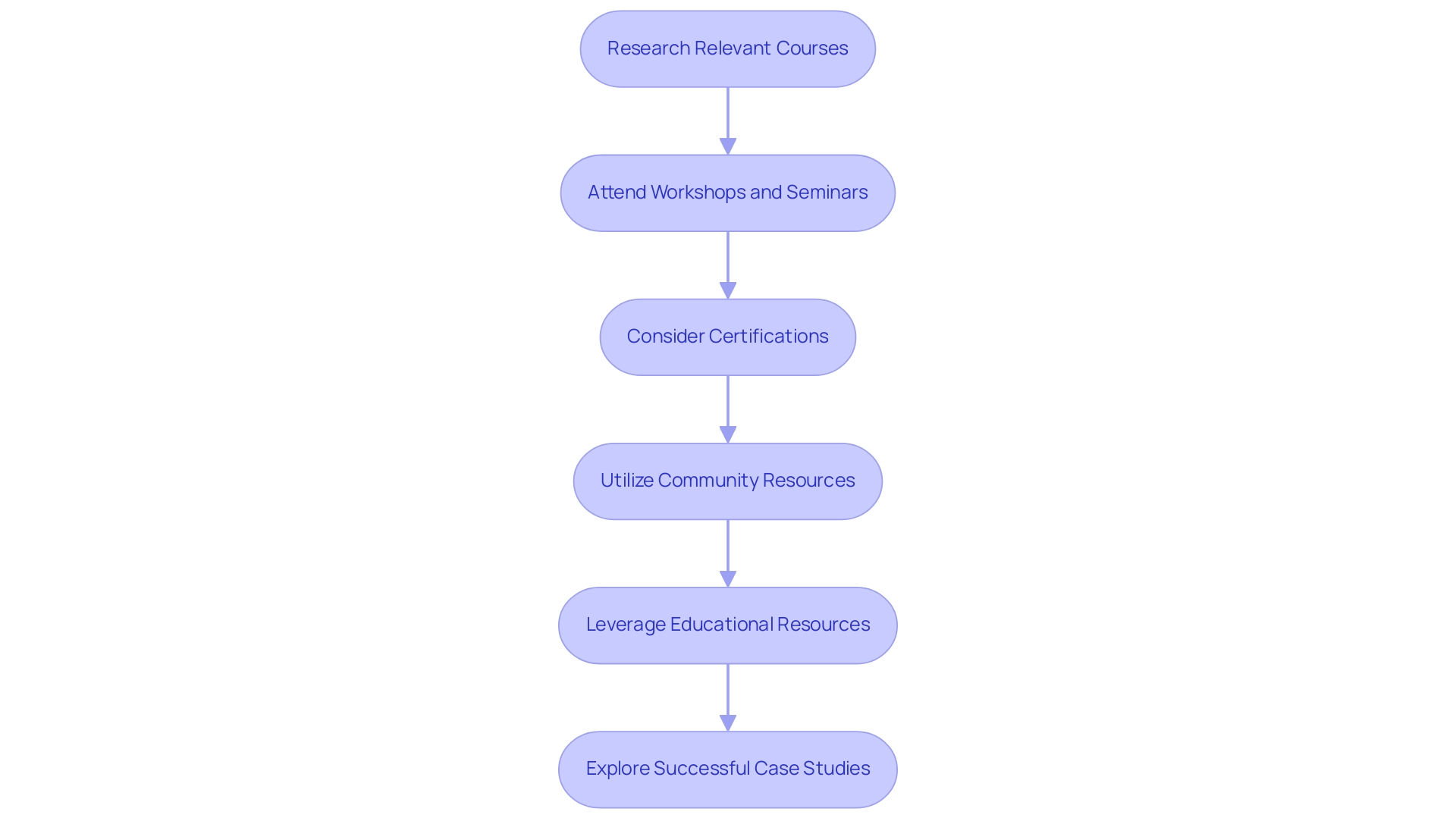
Taking Action: Leveraging Resources for a Successful Transition
To effectively leverage the essential resources available for your career transition, consider implementing the following actionable steps:
-
Create a Transition Plan: Start by outlining your professional goals, establishing clear timelines, and identifying the resources you will utilize. A well-organized shift strategy acts as a roadmap, guiding you through the intricacies of professional change. In today’s challenging job market, taking control of your destiny is crucial. As highlighted in “Your Career Revolution: Reimagine and Reclaim the Life of Your Dreams,” organized planning significantly enhances your likelihood of achieving successful changes, as demonstrated by the hundreds of thousands supported by The Entrepreneur’s Source in evaluating their career options.
-
Set Milestones: Break your change plan into smaller, achievable milestones. This approach not only makes the process less overwhelming but also allows you to track your progress effectively. Research shows that establishing specific milestones can boost motivation and accountability, resulting in a more successful change. Remember, there is no time like the present to act on your aspirations and make meaningful changes in your profession.
-
Stay Committed: Dedicate time each week to focus on your change activities, whether it involves networking, acquiring new skills, or applying for positions. Consistency is key; even small, regular efforts can accumulate into significant progress over time. Understanding the fastest-growing occupations can strengthen your commitment to your transition. Consider leveraging key resources, such as wind turbine service technicians and nurse practitioners, which can guide your professional choices. As noted in a case study by the Bureau of Labor Statistics, these fields are projected to experience significant growth, making them viable options for those transitioning in their professions.
-
Seek Feedback: Regularly consult with mentors or professional coaches to gain valuable insights and adjust your plan as necessary. Interacting with seasoned experts can offer you the emotional support and practical guidance necessary to manage your change effectively. As Greg Simpson, Global SVP of the Career Transition practice for LHH, states, “Combining technology with the emotional support of human interaction will ensure solutions remain both scalable and effective.”
-
Utilize Coaching Services: Consider taking advantage of the no-cost coaching services offered by Find Your Career 2.0. These services provide extra assistance and direction as you navigate your professional changes, helping you overcome obstacles such as age restrictions and the shrinking job market.
By following these steps, you can create a robust framework for your career transition, ensuring that you remain focused and motivated as you work towards achieving your professional goals. Additionally, the structured process offered by Find Your Career 2.0 can further support your journey towards financial independence and lifestyle fulfillment.
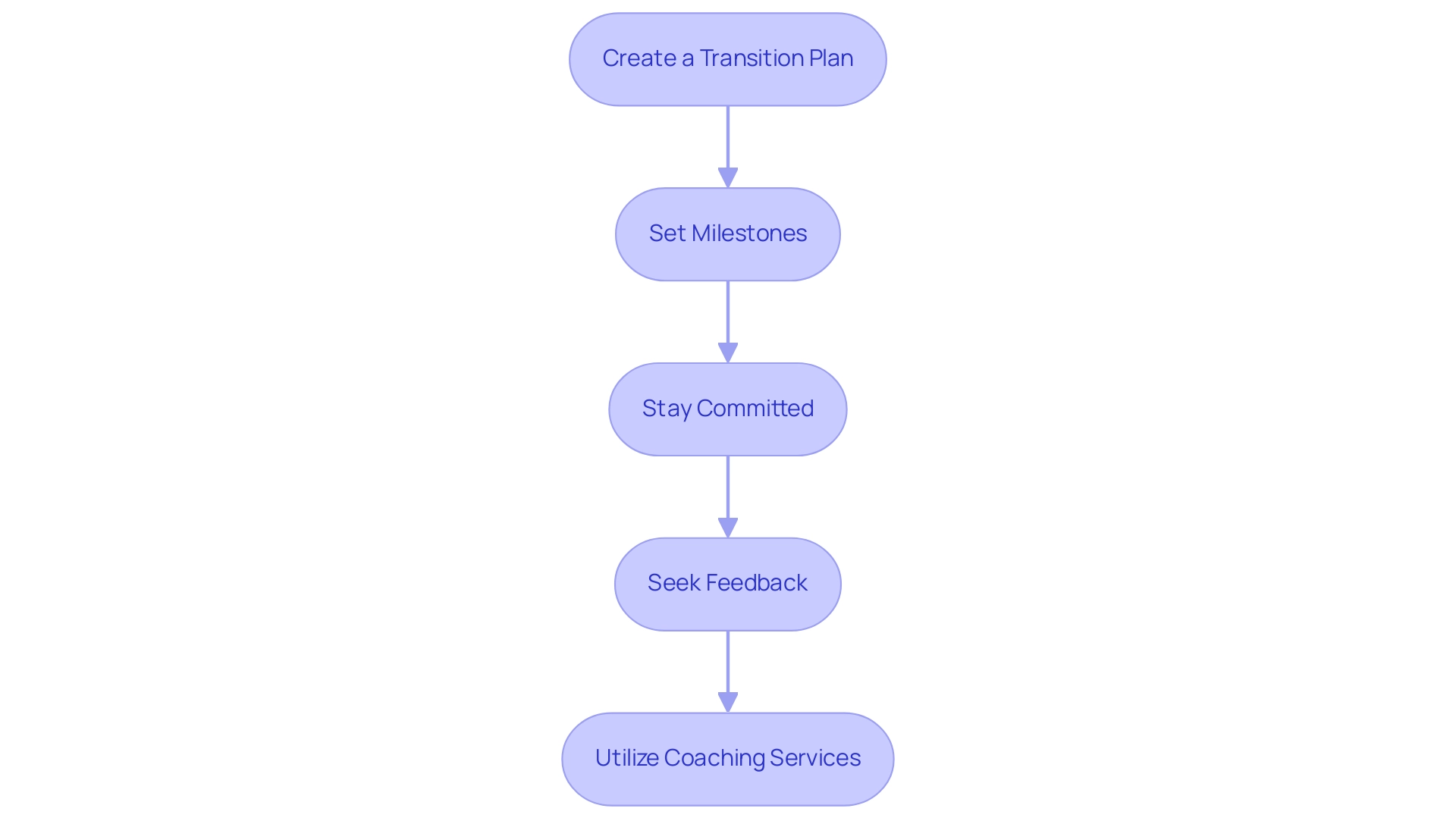
Conclusion
Navigating a successful career transition can feel overwhelming, and we understand the challenges you may face. It’s essential to acknowledge the emotional weight of such changes. By categorizing the resources available to you into personal, professional, educational, and financial aspects, you can begin to leverage your existing skills and networks. This strategic approach enhances your adaptability in a changing job market. Remember, recognizing the importance of your unique human capital is vital. Conducting a skills inventory, identifying gaps, and investing in your development will position you as a competitive candidate.
Have you considered how information technology and online learning can empower you? These tools can help you discover new opportunities and upskill effectively. Building a strong support network through mentorship and professional associations not only provides guidance but also opens doors to valuable connections. Financial planning is another crucial aspect of this journey. By assessing your financial situation and creating a budget, you can alleviate stress and focus on your career pursuits.
Ultimately, taking action is key. Creating a structured transition plan with clear milestones can help maintain your motivation and accountability. By remaining committed to this process and seeking feedback from mentors, you can navigate the complexities of career change with greater confidence. Embracing these strategies not only paves the way for fulfilling career transformations but also fosters a sense of ownership over your professional future.
The journey toward a brighter career path begins with the proactive utilization of available resources. You are not alone in this; we are here to support you as you reclaim control and achieve your aspirations.
Frequently Asked Questions
What are the personal resources I can leverage during a professional transition?
Personal resources include your existing skills, experiences, and personal networks. These assets are invaluable and can help you adapt and thrive in a new professional landscape.
How can professional resources assist me in my job search?
Professional resources, such as LinkedIn, job boards, and professional associations, can connect you with potential employers and provide insights into industry trends and opportunities.
Why is it important to stay informed about industry trends?
Staying informed is crucial because it allows you to adapt to the rapidly evolving job market. For example, over half of LinkedIn members anticipate job changes due to generative AI.
What educational resources should I consider during my transition?
Consider utilizing institutions and online platforms that offer courses and certifications relevant to your desired professional path. Recognized certifications can enhance your competitiveness and demonstrate your commitment to growth.
How can I ensure financial stability during my professional transition?
Having a financial cushion, such as savings, grants, or loans, is essential. Understanding your financial options can alleviate anxiety and allow you to focus on your professional objectives.
What steps can I take to effectively utilize my key resources during a job transition?
Key steps include conducting a skills inventory, identifying skill gaps, investing in development through training programs, and showcasing your skills on your resume and LinkedIn profile.
How can I identify skill gaps in my current skill set?
Research the skills that are in demand in your desired field and compare these requirements with your skills inventory to pinpoint any gaps that may hinder your transition.
What is the significance of upskilling during my career transition?
Upskilling is vital as industries evolve with new technologies. Investing in both technical and soft skills makes you a more attractive candidate and enhances your opportunities in the job market.
How can I present my skills effectively to potential employers?
Revamp your resume and LinkedIn profile to highlight your enhanced skill set clearly and articulately, making it easier for potential employers to recognize your value.
What role does employee development play in job retention?
Companies that prioritize employee development see 57% higher retention rates, emphasizing the importance of investing in your growth during a career transition.


